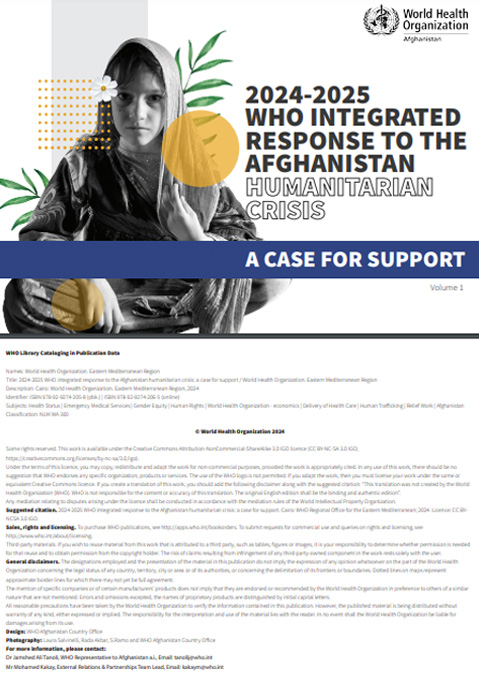Situation update
Afghanistan has the world’s third-highest malaria burden. The country accounts for 11% of cases in the WHO Eastern Mediterranean region. In Afghanistan, 5% of malaria cases are attributed to Plasmodium falciparum (P.f.) and 95% to Plasmodium vivax (P.v.). Over 76% of Afghans live in at-risk areas. There are 123 districts at high risk and 213 districts at low risk of malaria, with eastern Afghanistan having the highest burden. In 2017, 91% of confirmed P.f and 89% of P.v. cases were reported from six provinces: Nangahar, Laghman, Kunar, Nuristan, Khost and Paktika. Ten malaria deaths were reported from Nangahar (seven cases), Kabul (two cases) and Kunar (one case), while a significant reduction, particularly in P.f., is noted in the northeastern, northern and western regions. In 2017, the incidence rate of confirmed malaria cases was 8 per 1,000 and slide positivity rate (SPR) was 17.64%.
According to 2015 AfDHS, while 26% of households own at least one insecticide-treated bed net (ITN), only 3% of households have enough nets to cover all household members (assuming 1 ITN per 2 people). Few children under five years of age and pregnant women – the most at-risk groups – slept under an ITN. There was a gap between ownership and use of ITNs: only 17% of children under age five and 15% of pregnant women in households with a net used the net the night before the survey. In 2016-17 around 2.8 million ITNs were distributed, which should have helped improve the situation.
Achievements
Provided technical support for the assessment of malaria surveillance systems.
Technical and financial support was provided to pilot the Malaria and Leishmaniasis Information System (MLIS) to improve surveillance.
Facilitated assessment on insecticide resistance patterns.
Trained 59 master trainers on MLIS in the scaling up of implementation.
Conducted monitoring and evaluation of malaria control and elimination activities through CCM oversight committee.
Revised National Malaria Treatment guidelines.
Facilitated and coordinated the revision of the National Malaria Strategy – 2018-2022.
Provided information education materials for health facilities to enhance public awareness.Programme risks and challenges
Limited financial support to cover all components of the National Strategy, specifically lack of support for the implementation of the Pf elimination programme in recommended provinces.
Limited skilled staff at service delivery and programme management levels.
Weakness of the monitoring system, especially quality assurance of laboratory services.
Poor health seeking behavior in communities.
Programme Risks and Challenges
Limited financial support to cover all components of the National Strategy, specifically a lack of support for the implementation of the Pf elimination programme in recommended provinces.
Limited skilled staff at service delivery and programme management levels.
Weakness in the monitoring system, especially with quality assurance of laboratory services.
Poor health-seeking behaviour in communities.
Way forward
Ensure universal coverage with malaria diagnosis and case management through strengthening the capacity of health facilities and Community-based Management of Malaria.
Ensure effective coverage by Long Lasting Insecticidal Nets (LLINs) in high-risk provinces.
Enhance the capacity of National Malaria Control Programme staff on programme management, service delivery and M&E.
Regular monitoring of malaria drug efficacy and insecticide resistance.












